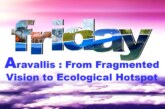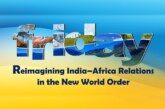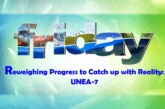Excerpts from an interview of Ms. Karen Sack, Co-Founder and Executive Director, Ocean Risk and Resilience Action Alliance (ORRAA)by Dr. Arvind Kumar, Editor, Focus Global Reporter
Ms. Karen Sack is a co-founder and Executive Director of the Ocean Risk and Resilience Action Alliance (ORRAA), a unique multi-sector collaboration between the private sector, governments and civil society designed to build resilience in the regions and communities most vulnerable to ocean risk, by pioneering finance and insurance products that incentivise investment into nature-based solutions. She has spent her career working on ocean conservation, advocacy and policy and has spoken and written extensively on ocean conservation, climate and sustainable finance.
She previously served as CEO of Ocean Unite, a non-profit co-founded in 2015 by Karen, Sir Richard Branson and former Costa Rican President José María Figueres to engage impactful voices at key moments that matter to catalyse ocean conservation action. Before that, she was Senior Director for International Oceans at The Pew Charitable Trusts where she initiated the Global Ocean Commission. She has also been head of Greenpeace International’s Political & Business Unit and of their international oceans campaign. She has spearheaded global campaigns to secure a new high seas biodiversity treaty, establish large marine reserves and sanctuaries, reform the EU’s Common Fisheries Policy, end illegal fishing and high seas bottom trawling, and drive political and policy action to protect marine species. Karen has post-graduate degrees in international environmental law and in international political economy. She is originally from South Africa and now lives in the United States.
INTERVIEW
EDITOR: In your view, what does a resilient, thriving ocean look like in 2050?
MS. KAREN SACK: By 2050, if not well before, we (humans), would have realised that a healthy planet requires a healthy ocean, which means an ocean full of life. We will have closed the high seas – our common international waters – to all extractive or destructive activities, including industrial fishing and any minerals extractions. Shipping across these seas would still be allowed, but ships would run on renewable energy and engine noise would be a thing of the past.
This vast fully protected marine area, covering two-thirds of the Ocean would be like a huge marine nature and climate bank, regenerating and restoring marine life and in so doing, the carbon carrying capacity and biodiversity generating capacity of the ocean.
We also would have ended all harmful fishing subsidies so that large industrial fishing and fishing-support vessels would not be able to go and fish any remaining healthy fish stocks in the waters of distant countries. All countries would have implemented requirements allowing only well-managed artisanal fishing within 12 nautical miles from their coasts and have highly protected 30-50 per cent of their waters. There would be no off-shore oil and gas drilling, but well-positioned off-shore renewables Healthy and vibrant coastal ecosystems would have been restored and flourishing, protecting coastal communities from rising sea levels and extreme storms; and, acting as nurseries, carbon sinks and toxin filters to prevent any remaining run-off from land entering the Ocean.
Single use plastics would have been replaced with sustainable bioplastics and strong waste management systems would be in place to prevent land-based waste from entering the sea. People would be enjoying the thrills and calm of a vibrant ocean which would be supporting livelihoods and recreation.
EDITOR: With the recent adoption of the High Seas Treaty, what opportunities and challenges do you foresee in its implementation, particularly for vulnerable coastal communities?
MS. KAREN SACK: The High Seas Treaty is an essential enabling element for us to achieve a healthy ocean by 2050. It takes elements of the Law of the Sea Convention – which we often call the ‘Constitution for the Ocean’ and enables countries to work together to focus on how to keep life in the Ocean rather than extracting it. It is one of the most significant international environmental agreements since the 2015 Paris Agreement. The huge opportunities are for the international community to act together quickly to protect large international areas of the ocean and ensure that among other things, capacity building and marine technology transfer helps developing countries in effectively implementing the treaty. The challenges include ensuring that the vast majority of countries adhere to the terms of the treaty, that it is quickly implemented, adequately financed, and that the benefits are equitably shared. None of these are insurmountable. The biggest opportunity and challenge is political will – which is a renewable resource, so hopefully forthcoming!
EDITOR: What role do financial institutions and the insurance industry play in reducing ocean risk, and how does ORRAA foster collaboration between these sectors and governments?
MS. KAREN SACK: The importance of coastal and ocean ecosystems to the global economy cannot be overstated. Two-thirds of publicly listed companies could be exposed to up to $8.5 trillion worth of value at risk over the next 15 years without immediate action to transition to a regenerative and sustainable blue economy. But transitioning to a sustainable ocean economy could mitigate over $5 trillion in losses while unlocking new growth avenues and reinforcing financial and environmental resilience. ORRAA’s Coastal Risk Index (CRI) has found that USD$363 billion worth of coastal assets would be at risk of flooding without the protective benefits of coastal ecosystems and 14.2 million more people would be flooded annually without coral reefs and mangroves providing the first line of defence against coastal flooding and storm surges. This is the value of nature on our doorstep.
The way that the finance and insurance community invests, what they prioritise and deprioritise can mean the difference between trillions of dollars of value being made more resilient or exposed to increased risk and vulnerability. This is why we started ORRAA. It is the only multi-sector collaboration connecting finance and insurance, governments, multilaterals, civil society, and local partners, to pioneer finance and insurance products that incentivize investment into coastal and ocean resilience. The mission, by 2030, is to activate at least USD$500 million of investment to build the resilience of 250 million climate vulnerable coastal people in the Global South. Because the Ocean is living capital. When we invest in its health, we invest in our own.
Healthy ecosystems are productive assets that compound in value. If we consider nature as essential infrastructure, and coastal ecosystems as protective infrastructure, then we recognise that mangroves, reefs, seagrasses and sand dunes provide flood control, carbon capture, and fish stock regeneration. Unlike concrete structures, they don’t start to degrade as soon as they are built, but get stronger over time; and they have a high return on investment: nature-based solutions offer 4-10x cost savings over gray infrastructure.
EDITOR: Can you share examples of innovative finance or insurance products that ORRAA has pioneered to address ocean risk and climate adaptation?
MS. KAREN SACK: Absolutely, ORRAA and our over 125 members are at the right place at the right time to deliver solutions. We connect the beachfront to the boardroom: frontline actors to philanthropies, governments, multilaterals, banks, asset managers, insurers and institutional investors as we build a capital market for the ocean that has high integrity and works for our common future.
There are currently over 60 projects in the ORRAA pipeline that include the development of micro- and macro-insurance tools, blue carbon, biodiversity and resilience credits, blue bonds, funds and tech applications that open the way to greater financial security. On the insurance side of things, we have helped support the development of parametric insurance for Coral Reefs so that there can be quick payouts to trained community workers after extreme storms who can earn money helping to rehabilitate the reefs while their tourism jobs are on hold to allow for recovery. We’ve also worked with partners to develop livelihood insurance for small-scale fishers so that they do not have to go out and fish in dangerous weather or if ill; and it encourages more sustainable fishing. Then we’ve been supporting financing mechanisms for Marine Protected Areas as well as de-risking and encouraging investment into Small Island Developing State Economies through supporting the development of the Nautilus Blue Guarantee Company and Outrigger Impact.
EDITOR: ORRAA’s mission includes driving $500 million in investment into nature-based solutions by 2030. What progress has been made, and what are the main barriers to scaling up blue finance for ocean resilience?
MS. KAREN SACK: As we mark our five-year anniversary, we are seeing the early results of our work. We have activated nearly USD$120 million in investment into the development and deployment of ocean finance and insurance products that are gender, nature and climate positive in the Global South of which ORRAA has directly invested $20million – a leverage ratio of 5:1. Through this, we have supported over 340,000 climate vulnerable coastal people and are on track to deliver at least 10 new finance products to market by the end of 2025.
But we recognise that this is just a drop in the Ocean. Two key barriers come to mind. First, the lack of knowledge and understanding about the value of the Ocean and coastal nature. Once we have explained that a healthy ocean is essential to life on Earth as the world’s largest carbon sink, reservoir of biological diversity and our planet’s environmental and economic engine, the listening begins. And that, of course, leads to the opportunity. Because despite having an estimated value of USD$24 trillion,the Ocean receives less than 1% of global capital flows, and UN Sustainable Development Goal 14: Life Below Water (SDG 14) receives the least amount of investment of all the SDGs.
The second barrier is the perceived lack of an investable project pipeline. This is the single most cited issue deterring potential investors from engaging. They often struggle to see viable, sizeable financing opportunities in coastal and ocean Nature-based Solutions (NbS), even though these solutions effectively build resilience and reduce risk exposure for vulnerable coastal communities. That’s why we focus on building the pipeline from the bottom-up and from the top-down. ORRAA’s Innovation and Product Pipeline incubates, innovates, and accelerates the development of finance and insurance products that invest in coastal and ocean natural capital. We make grants of up to USD$500k to help turn early-stage locally led ideas from the Global South into structured, “investment-ready” projects that are nature, climate and gender positive. This ensures that the innovative solutions already emerging on the ground can be replicated and scaled into bankable propositions. Then, our Sea Change Impact Financing Facility (SCIFF) is developing financial instruments and platforms to accelerate the build-out of a robust capital market for the ocean, offering multiple potential avenues through which private sector investors can engage and invest, from impact funds and guarantees to match-making and accelerator platforms, offering opportunities across the capital stack.
EDITOR: Beyond gender equity, how can we ensure that ocean finance is truly inclusive — empowering local fishers, Indigenous groups, and small-scale entrepreneurs?
MS. KAREN SACK: Coastal communities are on the front line of climate change and are significantly impacted by it. And gender equity sits at the core of that – if we don’t focus on that, then we will perpetuate the unworkable status quo. Women are disproportionately vulnerable to growing ocean related risks and often lack access to opportunities to build resilience. Advancing gender equality benefits to women and girls extends those benefits beyond the individual, to women’s households and communities, and helps countries realise their full development potential, especially within the context of a regenerative and sustainable blue economy. So gender responsive or transformative approaches are key to building resilience.
In addition to this it is absolutely critical that we sit at the same table, listen, hear and learn – and this is part of why we speak about working from beachfront to boardroom. We also need to connect communities working in different regions. This same approach applies when working with entrepreneurs or Indigenous Peoples. For example, we have been working with partners who focus on building the financial resilience of small-scale fishers in Southern Africa, Mexico and the Philippines. By introducing them to one another and enabling them to learn from one another, they can better tackle common challenges and teach us what the threads are that require action. Given the rising importance of ESG in global finance, how can financial institutions and investors be incentivized to prioritize ocean-positive ESG criteria, particularly in sectors like shipping, tourism, and fisheries, to accelerate the transition to a sustainable blue economy?
The major incentive is in reducing their potential risk exposure. There are several ways to do this. First, the finance sector needs to stop (or not start) investing in destructive extractive activities like offshore oil and gas, subsidised industrial fishing and seabed mining. They do not make economic or environmental sense.
Second, achieving understanding that financial returns alone are not the end goal – or sufficient in and of themselves. Integrating social returns, biodiversity positive outcomes, and climate resilience as fundamental elements of success ensures that short-term profit does not overshadow long-term community health and Earth system vitality. This also means recognising the value of nature on the balance sheet and accounting for it.
Finally, we need greater collaboration between governments, multilaterals, and private finance (including philanthropies and family offices) to create risk-sharing mechanisms like blended finance tools, guarantees and insurance that lower barriers to entry for private investors. We also need to recognise that smaller investments with fewer strings that move quickly are in the current moment, critical to deploy, rather than waiting for the billions and trillions.
EDITOR: IWF and ORRAA share a commitment to community-driven conservation. What lessons have you learned about making these efforts successful across philanthropy, the private sector, and governments?
MS. KAREN SACK: We need partners at the table from the very inception of the work as equals, working together, understanding the challenges on the ground, accommodating for those, and supporting action with skills and knowledge exchange. If we cannot listen and hear, understand and comprehend and also share in the day to day experiences of our partners, then we cannot sort through the challenges. And that, at its heart, is what ORRAA is about: joining the dots, engaging in ‘radical collaboration’.
EDITOR: What message would you like to share with policymakers, investors, and the public about the importance of urgent, science-based action for ocean resilience?
MS. KAREN SACK: The Ocean is living capital, when we invest in its health, we invest in our own. And the most incredible thing about the Ocean is its amazing ability to regenerate, if we let it. But it is in peril. The window is still open, but it’s closing, fast. We can put our heads in our hands, or we can put our heads and our hands to work.
With the science and evidence clear about the short timelines we have to address the biodiversity and climate crises, it is more important than ever that we are able to shape a common agenda across different sectors, break down siloes and shift paradigms.
ORRAA and our members are in the right place at the right time to deliver solutions and we invite others to join in this effort. None of us can do this alone. We need to work together, to be patient with capital and impatient with action. We need to move further and faster. Together, we are unlocking a trillion-dollar investment opportunity that reduces risk and drives environmental, economic, social and cultural security. We need to stop this trajectory of degradation and realise the economic, social and environmental opportunity that our ocean harbours.
……………






